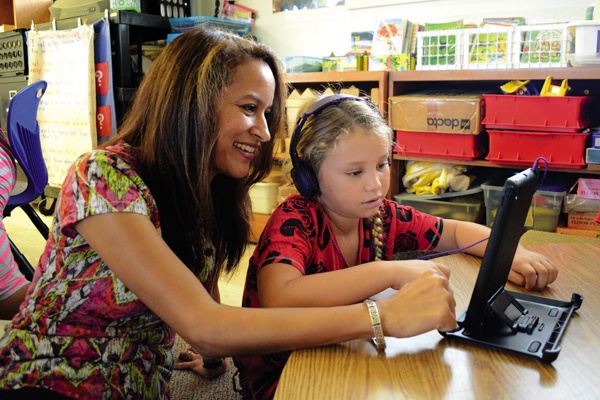KILAUEA — A public school teacher on Kauai’s North Shore has a problem. Her second-grade students are obsessed with solving math equations. And they love to read, too — until the cows come home. “They want to do math all
KILAUEA — A public school teacher on Kauai’s North Shore has a problem. Her second-grade students are obsessed with solving math equations. And they love to read, too — until the cows come home.
“They want to do math all the time, they want to do reading all the time, all day long,” Kilauea Elementary School teacher Michelle Gibson said.
What’s the secret to her classroom success?
Earlier this month, her 24 students received the first 30 iPad minis from a pilot program that aims at eventually providing technology-based education to all of the school’s nearly 300 students.
“It really helps our kids to be actually using the skills that they need in the 21st century,” Principal Sherry Gonsalves said. “We’re hoping to be able to be truly training them for college career readiness.”
She said the students were excited to have the technology in their hands.
“I got a medal,” second-grader Tiana Simpson said after successfully finishing a series of math equations on the iPad.
Gibson said each student responds in a different way to the apps.
Simpson’s classmate, Zalyah Caldanas, said it was easier to add on the iPad when she used an app with dice.
But Dylan Stagg would rather use numerals.
“It’s really hard to use the dice,” said the second-grader.
The first iPads were obtained through DonorsChoose.org, an online charity that connects public school teachers and individual donors. In January, if all goes as planned, the Rotary Club of Hanalei will provide 100 additional iPad minis.
North Shore resident and school volunteer Ric Cox said the current plan is for every student to have access to the iPads every other day.
“That’s how we can get by with half as many iPads,” said Cox, whose efforts proved instrumental to the success of the program.
After retiring 12 years ago in New York, Cox moved back to his native Illinois and opened an Internet-based business. Ten years later, he sold his business, packed up, and moved to Kauai, where he joined the Rotary Club to serve as a volunteer, he said.
Soon, he started volunteering at Kilauea School.
“I’ve never had children and I love being around children,” said Cox.
When Cox first brought up the idea of raising money for the school, Gonsalves told him technology was a priority, Cox said. Together, they came up with a plan to get iPad minis for the students.
Gibson’s class was picked for the pilot program because she was “the most enthusiastic and the most eager to learn about technology,” Cox said.
Finding funds for the program became possible after the head of the Hale Uluwehi Charitable Fund — who wished to remain anonymous — told school officials about DonorsChoose.org. Hale Uluwehi is one of the website’s major supporters, Cox said.
Gibson then spearheaded the fundraising efforts. With a goal of $18,000, parents and friends raised $5,000. The remaining funds were donated by Hale Uluwehi, according to Cox.
Once the pilot program is fully implemented, and assuming the teachers like the iPad minis, the Rotary Club will step in and buy the 100 additional iPads.
In the classroom, with an iPad in hand, the children interact with each other, ask questions, cheer when they get things right and call the teacher often for help.
There is no alienation there.
The children also follow a strict set of rules — that they helped create — to make sure the iPads stay in good shape.
And no one ignores the teacher.
“One, two, three, eyes on me, hands on your shoulders,” says Gibson, and the children immediately look at her.
Right now, her students are learning about penguins, and the project involves Internet searches and good ol’ paper.
“It was a little complicated to learn before (the iPads),” second-grader Nila Stedmans said.
But the students are not getting away with only using iPads.
“I still think they need the paper and pencil, but everything is moving toward electronics,” said Gibson.
She added third through sixth graders do testing on the computer, and the school is trying to get the young ones used to it, because soon, they may have to do their testing on the computer, too.
Gibson’s students use the iPads three days a week for about two hours each day. Fifth graders use the iPads for two days out of the week.
Besides pushing for fundraising efforts through DonorsChoose.org and at the Rotary Club, Cox donated much of his money to the school’s project. And he says it hasn’t been that hard to round up other donors.
“There’s a lot of money on Kauai, because there are a lot of professional retired people here,” said Cox.
Whenever he says the money will go toward education, people just pull out a checkbook and write a check, Cox said.
“Our greatest contribution could be through helping the young people on the island,” he said.
Gonsalves said the school has a detailed plan to educate teachers, students and parents in how to implement the program. It’s also looking at integrating technology across the board, because it’s a skill that students will need to prepare them for careers in the 21st century.
And it’s not just that the school is being given the iPads, she said.
The teachers volunteer time to get trained, and the school is going to offer training opportunities for students and parents.
“The sustainability that’s built into this plan is amazing,” she said.


